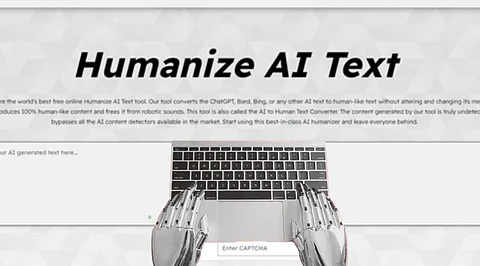

Artificial Intelligence (AI) has revolutionized content creation in recent years. From blog posts and ad copy to scripts and reports, AI-based solutions like ChatGPT and other large language models can create content at lightning speed. But while these solutions potentially scale and are efficient, the created content may sometimes sound forced, stilted, or emotionally barren. That is where AI to human text converters come into play—a new generation of software that humanizes AI-created content and makes it resonate more with real readers.
Language models trained on huge datasets generate factual and grammatically correct text. However, they lack natural flow, tone, and empathy. Common characteristics of raw AI-generated text are:
Repetitive sentences
Excessive use of transitional words
Vague or generic statements
Lack of personality
Unnatural sentence patterns
While these won't at first glance be obvious, seasoned readers or editors will spot AI-writing a mile away. For businesses, brands, and manufacturers who want to build trust and rapport with their public, this can be a disappointment.
That's where the demand for a humanizing layer comes in—software that tidies up AI output and displays it in a fashion that will appear as though it was composed by a real person.
A human to ai text converter is a software application aimed at taking AI-generated content and rebalancing it to duplicate human writing style. Such converters read content for patterns typical of machine-generated content and thereafter rewrite or improve it to make it more readable, more natural-sounding, and more emotionally engaging.
Instead of just paraphrasing, advanced converters employ:
Contextual understanding
Tonal adjustments (e.g., making things sound conversational, professional, or friendly)
Syntax improvements
Vocabulary differences by demographics of audience
Emotion-based phrasing
In the process, they develop writing that not only reads more smoothly but also resonates with readers on a human level.
Behind the scenes, AI to human text converters employ a mix of techniques, which include:
Natural Language Processing (NLP): to identify unnatural patterns of AI-generated text.
Tone detection and rewriting algorithms: to rewrite stiff or formal writing into more human-like language.
Machine learning algorithms: human-written text that is trained to create more natural phrasing and structure.
Most of the tools also allow users to select a tone or audience type, so there is more control over the output.
Having an ai to human text converter as part of your content process offers several important advantages:
Humanized writing is easier to read. Sentences are more organized, transitions are smoother, and ideas follow better—keeping readers hooked for longer periods.
AI can feel unfriendly. Humanized writing can express emotions, empathy, and personality—which brands need to build customer relationships.
Audiences are more likely to trust content that reads like a personal and natural conversation. AI to human converters help eliminate the "robotic" tone that would otherwise kill trust.
Search engines are becoming more capable of identifying poor-quality or AI-spammy content. Humanized writing has a higher chance of ranking higher with greater user interaction and fewer bounce rates.
Instead of spending time rewriting AI-authored material from scratch, these tools offer a quick way of editing and publishing high-quality material, leaving writers' and editors' time free.
Who Can Benefit from AI to Human Text Converters?
These tools are relevant across industries and careers:
Content marketing professionals desiring SEO-rich, natural-sounding content.
Self-employed writers using AI as first drafts but desire adjustments to tone.
eCommerce brands enhance product copy and email campaigns.
Educators and students ensure academic content meets natural writing standards.
Businesses and agencies producing client-ready blog posts, reports, or newsletters.
Whether you’re writing for a corporate blog, a personal project, or client work, a well-humanized article can make a significant difference in impact and reception.
There are numerous tools available, but not necessarily the same level of finesse. Seek out platforms that:
Offer various tone options (professional, casual, empathetic, etc.)
Support content personalization
use up-to-date language models
Prioritize privacy and data security
Support long-form content
One such tool is ai to human text converter, which is also renowned for producing refined, natural-sounding content perfect for blogs, social media, marketing copy, and more.
AI content has been a powerful tool for businesses and content creators to utilize, but it is not flawless. If you want your content to resonate with readers on an actual level, sound fresh, and engage them, it's not simply a matter of using AI.
AI-to-human text converters fill the gap between robotic copy and reader-friendly storytelling. They polish language, bring emotion, and make sure your message resonates—without compromising the speed and efficiency of AI.
In a world where content quality determines trust, conversions, and brand loyalty, being smart enough to use tools that make your writing more human is not only smart—it's crucial.
